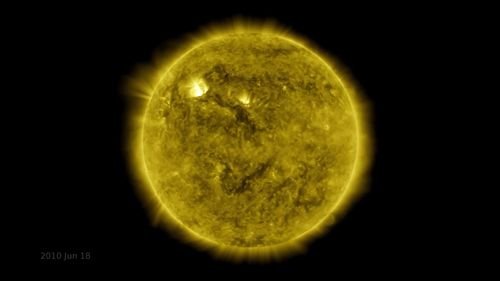The sun has started a new solar cycle, experts say

Every 11 years, the sun completes a solar cycle of calm and stormy activity and begins a new one.
It’s important to understand the solar cycle because space weather caused by the sun — eruptions like solar flares and coronal mass ejection events — can impact the power grid, satellites, GPS, airlines, rockets and astronauts in space.
And we just got a bit more information about how the sun’s activity could impact us.
The new solar cycle, Solar Cycle 25, officially began in December 2019, according to an announcement by the Solar Cycle 25 Prediction Panel of international experts on Tuesday. It can take as long as 10 months to calculate when the new cycle starts, since the sun is so variable, which is why it was announced Tuesday.
Solar Cycle 25 will be very similar to the one we just experienced for the last 11 years, according to the prediction. The next solar maximum, when the sun is experiencing peak activity, is predicted to occur in July 2025. During that time, it’s possible for solar flares or other eruptions for the sun to disrupt communications on Earth.
Solar Cycle 24 was the fourth smallest cycle on record and the weakest cycle in 100 years, said Lisa Upton, co-chair of Solar Cycle 25 Prediction Panel and solar physicist at the Space Systems Research Corporation, during a press conference Tuesday.
While Solar Cycle 24 was below average, it wasn’t without risk. An epic storm erupted from the sun in July 2012, but missed colliding with Earth.
“Just because it’s a below-average solar cycle, doesn’t mean there is no risk of extreme space weather,” said Doug Biesecker, panel co-chair and solar physicist at NOAA’s Space Weather Prediction Center, in a statement. “The Sun’s impact on our daily lives is real and is there. (We are) staffed 24/7, 365 days a year because the Sun is always capable of giving us something to forecast.”
Biesecker compared it to hurricane season. Even if many of the storms don’t make landfall, the few that do could really matter, which is why space weather predictions are so important.
Sunspots, which are dark spots on the sun, help scientists track the sun’s activity. They are the origin point for the explosive flares and ejection events that release light, solar material and energy into space.
During the peak of solar activity in the last cycle, 120 sunspots were tracked. About 115 sunspots are predicted for the peak of this new cycle. In comparison, an above-average active cycle would include more than 200 sunspots.
“We keep a detailed record of the few tiny sunspots that mark the onset and rise of the new cycle,” said Frédéric Clette, prediction panelist and director for the World Data Center for the Sunspot Index and Long-term Solar Observations at the Royal Observatory of Belgium in Brussels. “These are the diminutive heralds of future giant solar fireworks. It is only by tracking the general trend over many months that we can determine the tipping point between two cycles.”
The more scientists learn about the solar cycle, the better they can prepare to predict when these events may occur.
Over the course of a solar cycle, the sun will transition from a calm period to one that is very intense and active. This activity is tracked by counting sunspots on the sun and how many are visible over time. During the peak of this activity, the sun’s magnetic poles flip. Then, the sun will grow quiet again during a solar minimum. And this takes place about every 11 years.
Over the past year and a half, the sun was quiet with barely a sunspot noticeable on its surface.
The solar minimum occurred in December 2019. During this period, the sun is still active, but it’s more quiet and has less sunspots. Since then, the sun’s activity has slowly increased. The new prediction suggested that the sun’s activity will peak in July 2025.
A total solar eclipse will cross North America in April 2024, which may afford scientists with the opportunity to observe the sun’s activity, like solar eruptions or sunspots, during the event.
“We hope that an eclipse close to solar maximum will not only show us an awe-inspiring corona, but also some big, interesting sunspots on the face of the Sun to help us learn about living inside the atmosphere of an active star and the space weather it creates,” said Valentin Martinez Pillet, director of the National Solar Observatory in Colorado, in a statement.
Now that we’re past the minimum, scientists have predicted the sun’s activity will increase over the months and years to come as we approach July 2025.
“As we emerge from solar minimum and approach Cycle 25’s maximum, it is important to remember solar activity never stops; it changes form as the pendulum swings,” said Lika Guhathakurta, solar scientist at the Heliophysics Division at NASA Headquarters in Washington, in a statement.
Preparing for the sun’s activity
Although the panel got the timing of the maximum wrong during the last cycle, they have improved their methods of prediction, Biesecker said.
“We treated the sun as one big ball of gas, but the hemispheres, south and north, behave independently,” he said. “During the last solar cycle, they were out of phase with each other more than ever before, which ruined our forecast.”
But monitoring the magnetic fields in the polar regions of sun has consistently provided the best forecast, he said.
“There is no bad weather, just bad preparation,” said Jake Bleacher, chief scientist for NASA’s Human Exploration and Operations Mission Directorate at the agency’s headquarters, in a statement. “Space weather is what it is — our job is to prepare.”
Experts said that space weather is transitioning from a focus of research to a more national operational priority across a multitude of agencies, including NASA, the National Oceanic and Atmospheric Administration, the Department of Homeland Security, the Federal Aviation Administration and many others.
This allows for better planning, preparedness and protection from space weather hazards.
The agency NOAA shares space weather predictions from its Space Weather Prediction Center in Colorado and has satellites monitoring space weather in real time. It has a hotline with electrical grid operators to warn them, so they can prepare and keep the power on, Biesecker said.
And NASA researches the near-Earth space environment, which will help improve forecasting of space weather.
In addition to protecting the technology we depend on, space weather predictions will grow increasingly important for astronauts in space.
The NASA Artemis program seeks plans to send humans out of low-Earth orbit, where the International Space Station resides, and back to the moon and on to Mars in the future.
The Gateway, an outpost that will orbit the moon and allow for astronauts to land on the moon, will host research to study space weather and radiation that astronauts and the hardware they use will experience when they return to the moon. Scientists at NASA can also use the Gateway to test items astronauts will rely on, like food and pharmaceuticals, to see how space weather could impact their efficiency, Bleacher said.
Like preparing for weather events on Earth, anticipating space weather events allows for better preparation on Earth. Agencies are working together to ensure that the space weather paradigm is similar to the weather paradigm.
“Just as NOAA’s National Weather Service makes us a weather-ready nation, what we’re driving to be is a space weather-ready nation,” said Elsayed Talaat, director of Office of Projects, Planning and Analysis for NOAA’s Satellite and Information Service in Silver Spring, Maryland.
That includes NOAA’s Space Weather Follow-On L-1 observatory, which is expected to launch in 2024 ahead of Solar Cycle 25’s predicted peak.
“This is an effort encompassing 24 agencies across the government, and it has transformed space weather from a research perspective to operational knowledge,” Talaat said.



